Parsing out the role of dopamine D4 receptor gene (DRD4) on alcohol-related phenotypes: A meta-analysis and systematic review
- PMID: 31149768
- PMCID: PMC6885089
- DOI: 10.1111/adb.12770
Parsing out the role of dopamine D4 receptor gene (DRD4) on alcohol-related phenotypes: A meta-analysis and systematic review
Abstract
Genetics account for moderate variation of individual differences in developing alcohol use disorder (AUD), but it is unclear which genetic variations contribute to AUD risk. One candidate gene investigated due to its association with AUD is the dopamine D4 receptor gene (DRD4), which contains a 48-base pair variable number tandem repeat (VNTR) in exon 3 of its coding region. To date, no quantitative synthesis of the published literature on the effects of DRD4 VNTR variation on alcohol-related phenotypes has been conducted. MEDLINE, Embase, Web of Science, and PsycInfo were searched for studies that reported on alcohol craving, alcohol consumption, severity of AUD, and case-control (AUD versus no diagnosis of AUD) studies in DRD4L (seven repeats or more) carriers compared with DRD4S (six repeats or less) homozygotes. Random-effects meta-analysis was used for all analyses. A pooled sample size of 655 to 13,360 of 28 studies were included. Compared with DRD4S homozygotes, DRD4L carriers had increased number of drinking days (SMD: 0.205; 95% CI: 0.008 to 0.402), binge drinking days (SMD: 0.217; 95% CI: 0.0532 to 0.380), and severity of AUD (SMD: 0.143; 95% CI: 0.028 to 0.259). There was no difference between DRD4 VNTR genotypes on drinks per drinking day, largest number of drinks per day/occasion, and case-control analysis. It was not possible to conduct a meta-analysis of the craving data, but a systematic review of this literature found mixed results on DRD4 VNTR genotype effect. The present meta-analysis suggests DRD4 VNTR variation may be a risk factor for problematic alcohol use. Our findings are limited, however, by the absence of ancestry data from studies included in our analysis, precluding our ability to adjust for population stratification. Due to the likelihood of type I error in candidate gene approaches, our work highlights the critical need for studies with larger and more inclusive samples that account for sex and genetic ancestry to fully understand this relationship.
Keywords: DRD4; alcohol use disorder; meta-analysis.
© 2019 Society for the Study of Addiction.
Conflict of interest statement
Conflicts of Interest and Disclosures:
The authors report no biomedical financial interests or potential conflicts of interest. The content of this article is solely the responsibility of the authors and does not necessarily represent the official views of the National Institutes of Health.
Figures



References
-
- Asghari V, Sanyal S, Buchwaldt S, Paterson A, Jovanovic V, Van Tol HH (1995) Modulation of intracellular cyclic AMP levels by different human dopamine D4 receptor variants. Journal of neurochemistry 65:1157–1165. - PubMed
-
- Bau CHD, Almeida S, Costa FT, Garcia CED, Elias EP, Ponso AC, Spode A, Hutz MH (2001) DRD4 and DAT1 as modifying genes in alcoholism: Interaction with novelty seeking on level of alcohol consumption. Molecular Psychiatry 6:7–9. - PubMed
-
- Bau CHD, Roman T, Almeida S, Hutz MH (1999) Dopamine D4 receptor gene and personality dimensions in Brazilian male alcoholics. Psychiatric Genetics 9:139–143. - PubMed
-
- Belsky J, Bakermans-Kranenburg MJ, Van IJzendoorn MH (2007) For better and for worse: Differential susceptibility to environmental influences. Current directions in psychological science 16:300–304.
-
- Chang F-M, Kidd JR, Livak KJ, Pakstis AJ, Kidd KK (1996) The world-wide distribution of allele frequencies at the human dopamine D4 receptor locus. Human genetics 98:91–101. - PubMed
Publication types
MeSH terms
Substances
Grants and funding
LinkOut - more resources
Full Text Sources
Medical

